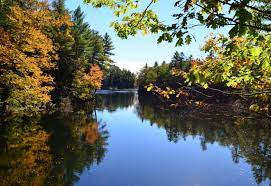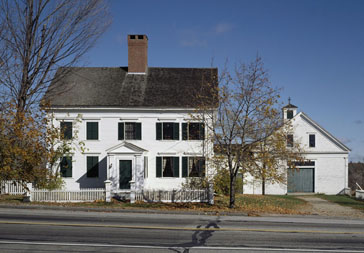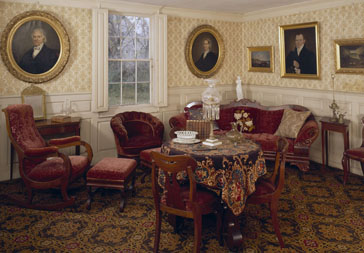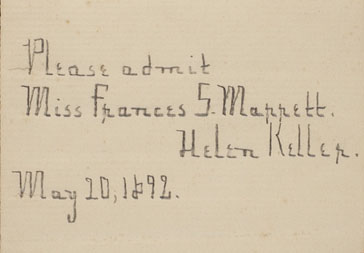 Between Two Rivers
Between Two Rivers
The land on which Marrett House sits stands strategically between the Saco River, called Shawacotuc, by the Wabanaki meaning “where the river flows out” or “country around the mouth of” and the Presumpscot River, or Presumskeag, meaning “Rough Places River” or “Ledges in Channel.” The town of Standish is just 3.5 miles east of Watchic Lake, meaning “At the Mountain,” and 2.2 miles from the southern edge of Sebago Lake, meaning “Big Still Water.” This is the fertile homeland of the Chouacoit, meaning “at the outlet”, the Saco tribe of the Wabanaki, “the People of the First Light.” The desire of others to control and wrest this bountiful land and its resources from the Chouacoit drove over a hundred and fifty years of bloodshed.
The Wabanaki are the indigenous people of Wabanakiak, “The Dawnland.” Wabanakiak consists of the places we call Maine, New Hampshire, Vermont, New Brunswick, Nova Scotia, Cape Breton Island, Prince Edward Island, Anticosti, Newfoundland, and the southern region of Quebec south of Saint Lawrence River. By archeologists’ accounts, the Wabanaki have been in this region for 13,000 years; oral history tells us that the Wabanaki have been of these lands since creation.
Due to disease, war, dispossession, and the genocidal policies enacted by the United States government, the Wabanaki suffered a population decrease of 96% since Europeans’ first contact with Turtle Island (North America.) The many diverse tribes and bands across Wabanakiak have amalgamated into five principal Nations: the Mi’kmaq (derived from the word “Ni’kmaq” meaning “my kin friends,”) Abenaki (derived from “Wabanaki,”) Wolastoqiyik “People of the Beautiful River” (Maliseet), Panawáhpskek “Where the Rocks Widen” (Penobscot,) and Peskotomuhkati “Pollock-Searing People” (Passamaquoddy.)
Rivers and other waterways are integral parts of Wabanaki identity and culture. They connected, fed and sustained the people’s communities. Waterways were important transportation corridors, and their shores places of seasonal fishing, hunting, socializing and trading. The land between the Presumpscot to the East and the Saco to the West was a sacred place overflowing with resources.
 “the river which I belong to”
“the river which I belong to”
The gifts of the waterways extended to the surrounding shores. This was good land to grow things. In 1605, French explorer Samuel de Champlain described seeing Chouacoit fields full of three sisters plantings (corn, beans and squash) and fruit vines. For the next ten years, the Chouacoit were swept up in a bitter war with the Micmacs and their allies who wanted these lands for themselves. In 1619, the entire Wabanaki population was devastated by the first epidemic of European disease. Although diminished in numbers, the Chouacoit remained on their land. For the next fifty years, English colonists would come and sign treaties promising to share the resources and land, and then ignore them. When hostilities broke out, the colonists would flee south. But each time, more returned.
The Wabanaki signed treaties as reciprocal agreements of shared inhabitation and resource use. They honored nature as they relied on its resources to survive. They understood the spiritual balance of the environmental cycle necessary to preserve those resources for everyone. The spring runs of salmon fed the people after the long winters until their crops grew again. The river and its tributaries enabled their transportation and communications with other trading groups. Colonists saw never-ending opportunities for profit. Turn fisheries into sawmills, use the water to drive the mills and transport the lumber to be sold overseas. They could then buy whatever else they needed. By 1730, the colonial government also recognized that cutting the Wabanaki off from the fish migrations they relied upon could be a strategy to strangle them into submission and eviction.
In 1739, the Wabanaki leader Polin, travelled to Boston two separate times to ask the governor of the Massachusetts Bay Colony, Jonathan Belcher, to enforce previous treaties that stipulated the installation of a seasonal fish passage. Polin told Belcher that he had something to say about “the river which I belong to.” When Belcher asked him what that river was, Polin said it was the Presumpscot. Fearing an outbreak of war if he did not, Belcher promised to see that Polin’s concerns were addressed. Despite that promise, no changes took place. Polin repeated his visit later that year with the same result.
Conflict and Colonizers
At the end of King George’s War in 1749, the Massachusetts colonial government began awarding tracts of land that they neither owned nor controlled to veterans of that war. In 1752, a tract of land was awarded to veterans Captain Moses Pearson and his company, including Sequent, identified as an Indian on the award document. Unlike other parts of midcoast Maine where friends of the Crown or wealthy Massachusetts colonists were the proprietors who would then recruit immigrants to do the hard work of settlement, Pearson and his fellow veterans were both proprietors and settlers of the land that would become first Pearsontown, later Standish.
After realizing that no treaty or requests would ever be recognized by the colonists, Polin fought with his people against the English in King George’s War and the French & Indian War. In 1756, Polin and his band left their encampment outside Sebago to ambush the local militia patrol. In the skirmish that followed, Polin was shot and killed.
Despite numerous attempts, including building a fort on the corner near where Marrett House is today, it took Pearson and his fellow colonists almost ten years to establish their town. In the decades after the end of hostilities, the colonists organized the settlement, divided and improved the land and built a meetinghouse. In 1785, Pearsontown was incorporated as the town of Standish, named after Miles Standish.
After the last raid in 1759, the Wabanaki chose to survive by dispersing throughout the state and continuing their lives, enduring and overcoming centuries of repression and disenfranchisement. Today, four Maine tribes comprise the Wabanaki – the Maliseet, Micmac, Penobscot, and Passamaquoddy. The people live on tribal lands and in towns and cities across the State. Each community has its own tribal government, community schools and cultural center. Each manages its respective lands and natural resources. The Wabanaki culture is alive and well. The People of the First Light will always be an integral part of Maine. In 2018, the Friends of the Presumpscot River installed a marker to commemorate Polin’s efforts to protect the river.
 Daniel Marrett
Daniel Marrett
In 1796 Reverend Daniel Marrett moved with his young wife Mary from Lexington, Massachusetts, to Standish, Maine, to become the new town parson. He purchased the handsome Federal-style house, built in 1789 for his predecessor, who had died unexpectedly. Daniel and Mary settled down and began raising their family. In eighteenth-century rural Maine, the minister was by far the most important man in town. The minister’s income was supposed to come from taxes imposed on the town’s citizens and regular gifts of foodstuffs. As was often the case, Marrett found that he could not support his growing family on that meager income, so he turned to another of his interests, pomology (the science of growing fruit). In addition to his work ministering to the citizens of Standish, Daniel Marrett operated a large apple orchard. He became the leading pioneer of grafting in Maine. He is also credited with introducing the first cooking stove in Standish.
Mary Marrett died in 1810, leaving Daniel a widower with six children between the ages of two and thirteen. By 1812 the forty–seven-year-old minister had married again, this time to twenty-seven-year-old Dorcas Hastings. Not only did she enthusiastically mother Daniel’s children, but she and Daniel would have eight more children over the next fifteen years. The back room on the second floor of Marrett House was divided into several much smaller spaces to accommodate all the children.
 Avery Marrett
Avery Marrett
Daniel and Dorcas’s eldest son Lorenzo graduated from Bowdoin College and became a successful lawyer in Cambridge, Massachusetts. Their third son, Avery, inherited Marrett House and the family apple business on the death of his father in 1836. Avery was a savvy businessman as well as a successful orchard manager. He quickly set about updating the house. In 1847 he married Elizabeth Weston, also the child of a minister, in the newly redecorated and refurnished parlor at Marrett House. They had seven children, six of whom lived to adulthood.
Avery’s commercial success enabled him to update the Federal house in the fashionable Greek Revival style. He raised the roof three feet to install a classic entablature. He added Greek Revival trim and details to not only the main house, but also the large new attached barn, wood shed, and ell.
In 1889 the extended Marrett family gathered for an elaborate commemoration of the one hundredth anniversary of the building of the house. Rooms were decorated with pine boughs in the Colonial Revival style. There was a printed program of activities. Frances Marrett even wrote a poem for the occasion that was printed and distributed.
 Caroline and Helen Marrett
Caroline and Helen Marrett
Reverence for the past and family history was carried on by Avery’s daughters. Caroline Marrett inherited Marrett house when Avery died in 1894. Her two surviving brothers had left Standish to pursue education and careers. Caroline, Helen, and Frances were each accomplished women. Helen became a teacher and was Preceptress of Gorham Farm Academy, which became the University of Southern Maine. Caroline was the true manager of the estate. She ran the farm and established the large Colonial Revival garden next to the house. An avid gardener, she was a self-taught botanist and naturalist who became known as an expert on the various types of lilies.
Avery’s daughters preserved the Marrett House parlor exactly as it was in 1847. The parlor that had been her parents’ pride as an example of their modernity had become a relic of a treasured past for Caroline and her three sisters. Joined by their sister Mary after the death of her husband in 1930, the sisters proudly continued the noblesse oblige tradition. When electricity came to the area in the 1930s, Marrett House was the first building to be illuminated. Caroline and Helen invited the whole town to come and observe the first demonstration of this modern marvel.
Caroline Marrett was an early member of Society for the Preservation of New England Antiquities, now Historic New England. It was her decision to donate Marrett House and all its furnishings to Historic New England to be run as a house museum. The sisters, including Frances, spent considerable time and resources organizing and preserving the house as they wished it to be presented.
 Frances Marrett
Frances Marrett
When Caroline died in 1944, the youngest Marrett sister inherited both the house and the job of preparing it for new life as a house museum. Frances had lived a sophisticated life in Boston. She was a teacher at the Perkins School for the Blind, where Helen Keller was one of her favorite pupils. Frances and her lifelong friend and fellow teacher Sarah Lilley shared an apartment in Boston. The two left mementos and descriptions of their special trip to Europe for the celebration of the turn of the nineteenth into the twentieth century.
 Becoming a Museum
Becoming a Museum
Frances Marrett died in 1944, having readied the house according to her sister Caroline’s wishes, leaving it to Historic New England. Sarah Lilley was given a life tenancy and became the first tour guide at Marrett House. Today, we delight in sharing the stories of this lively and remarkable family, and welcome visitors to this multi-layered home with its barns and beautiful garden, an example of “Yankee” family pride and tradition.

 Between Two Rivers
Between Two Rivers “the river which I belong to”
“the river which I belong to” Daniel Marrett
Daniel Marrett Caroline and Helen Marrett
Caroline and Helen Marrett Frances Marrett
Frances Marrett
